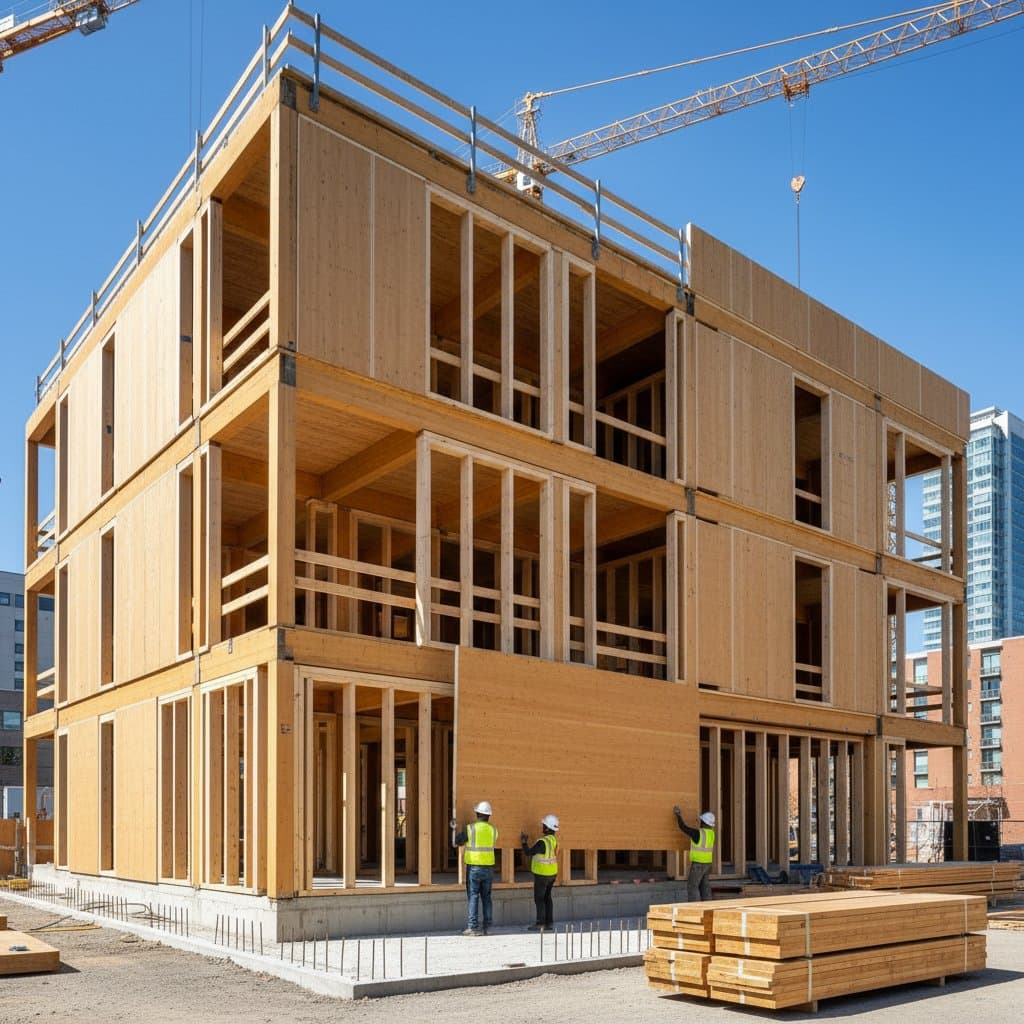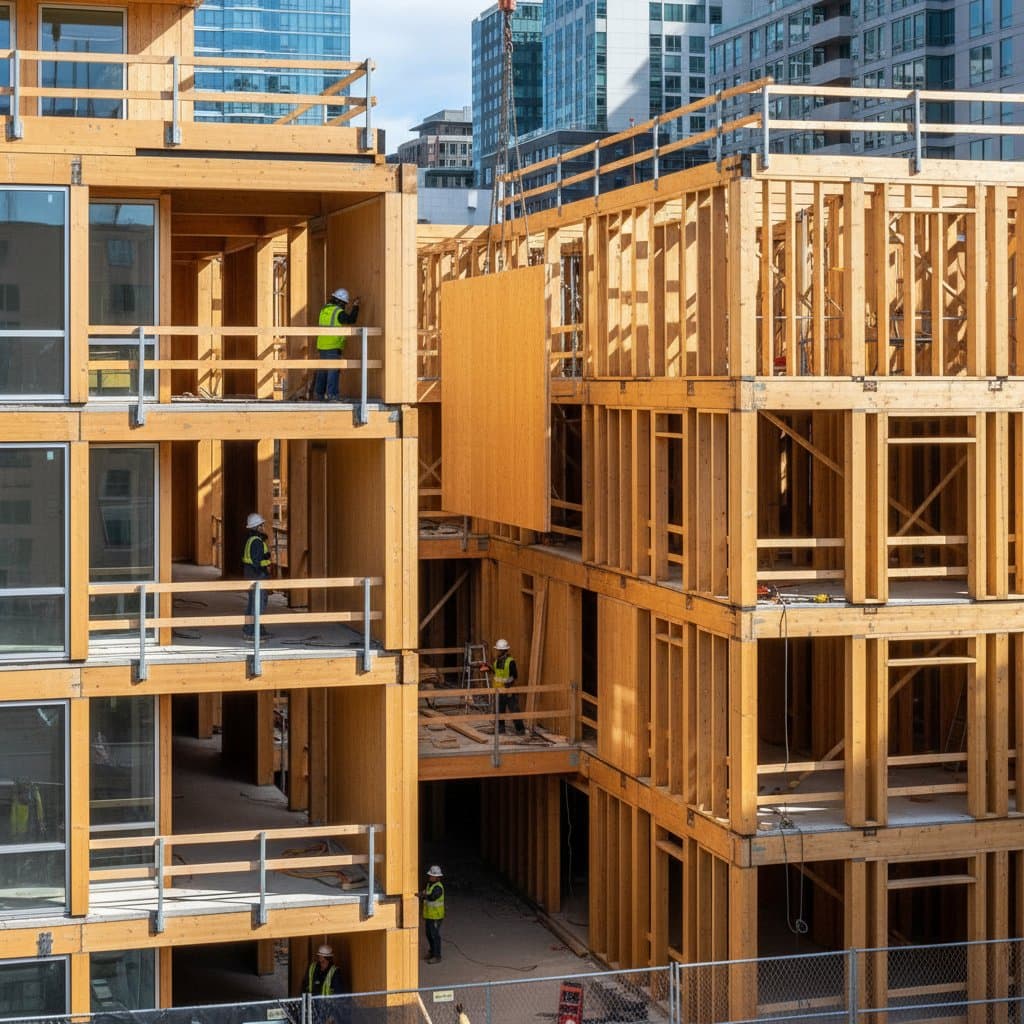Is Mass Timber More Cost-Effective Than Traditional Methods in 2025?
Mass timber construction reshapes building design and execution. This approach employs engineered wood products like cross-laminated timber (CLT), glue-laminated timber (glulam), and laminated veneer lumber (LVL). These components arise from layered and bonded wood segments, yielding robust panels and beams that rival concrete and steel in structural integrity while delivering a reduced environmental burden.
This analysis examines the cost dynamics of mass timber against conventional techniques, identifies key influencing variables, and evaluates outcomes from actual implementations.
Material Cost Comparisons
Initial perceptions suggest timber undercuts steel or concrete in price. Reality proves more nuanced, as mass timber expenses hinge on local availability, logistics, and production expertise.
Advantages Favoring Timber
- Accelerated timelines: Prefabrication enables swift on-site assembly, slashing schedules by up to 30 percent in many cases. Such reductions lower labor expenditures and site management fees.
- Streamlined foundations: Timber's reduced weight demands less robust bases, minimizing excavation depth and reinforcement needs.
- Minimized waste: Factory-controlled fabrication limits errors, with waste rates often below 5 percent compared to higher on-site discards in traditional builds.
Factors Elevating Timber Expenses
- Constrained supply networks: Regions without local production import CLT, inflating costs by 20 to 40 percent due to transport.
- Expert labor requirements: Installation demands crews versed in timber connections, potentially increasing wages by 10 to 15 percent where specialists are scarce.
- Code-mandated enhancements: Fireproofing or soundproofing additions, such as intumescent coatings, can add 5 to 10 percent to material budgets.
Despite these elements, integrated project evaluations frequently reveal timber achieving parity or savings when accounting for time and efficiency gains.
Evaluating Long-Term Expenses
Initial outlays represent only part of the equation; enduring costs shape true worth. Mass timber excels in domains impacting sustained operational costs.
Superior Energy Performance
Wood's natural insulation maintains consistent interior climates. In diverse weather zones, this quality curtails heating and cooling demands by 15 to 25 percent. Combined with advanced windows and barriers, timber enclosures surpass conventional assemblies in thermal efficiency.
Durability and Upkeep
Sealed mass timber endures comparably to concrete or steel when moisture is controlled. Contemporary sealants and barriers block water entry, while precise joint designs safeguard integrity.
Maintenance focuses on periodic checks and finish renewals, avoiding extensive fixes like concrete patching or steel rust treatment. These routines prove cost-effective and foreseeable.
Enhanced Market Appeal
Sustainability-focused structures draw occupants seeking eco-friendly and inviting spaces. Exposed wood's texture fosters quicker leasing, often boosting occupancy by 10 to 20 percent. This appeal elevates property values and resale prospects.
Design and Structural Versatility
Mass timber extends beyond low-rise applications. Engineering progress supports mid- and high-rise configurations, often in hybrid setups with steel or concrete for optimized performance.
Designers value the material's warmth and organic appearance. Structural experts commend its favorable strength-to-weight balance and reliable behavior. Constructors benefit from tailored prefabrication, aligning with precise spatial and visual goals.
Key Design Advantages
- Spacious layouts: CLT spans up to 40 feet without supports, eliminating many internal columns.
- Compact dimensions: Timber elements deliver equivalent load-bearing with 20 to 30 percent less bulk than concrete.
- Sound management: Layered assemblies achieve noise reduction ratings exceeding 50 decibels, ideal for multifamily or commercial use.
These attributes permit leaner designs, curbing material quantities and overall scale to trim expenses.
Overcoming Cost-Related Hurdles
Every building system presents obstacles. Addressing them ensures budget adherence.
- Fire standards and regulations: Timber's charring resistance aids compliance, yet supplementary tests or assemblies may extend approval processes by weeks.
- Moisture safeguards: Detailed planning and phased erection prevent exposure, averting potential 5 to 10 percent cost overruns from repairs.
- Supply fluctuations: Opt for established vendors to stabilize lead times at 8 to 12 weeks.
- Expertise gaps: Initial projects may incur 10 percent extra design hours; subsequent efforts streamline this.
Industry evolution mitigates these issues through expanded production, uniform standards, and growing proficiency, fostering cost predictability.
Strategies for Assessing Mass Timber Viability
Approach mass timber projects with deliberate planning to harness benefits.
- Consult seasoned teams upfront: Involve timber-savvy architects, engineers, and builders to refine designs and pinpoint savings.
- Perform comprehensive lifecycle assessments: Weigh materials against labor, schedules, upkeep, and utility projections over 50 years.
- Prioritize local sourcing: Domestic mills cut freight by 15 to 25 percent and shorten delivery to 4 to 6 weeks.
- Schedule for protection: Align erection with dry periods, using enclosures to shield panels.
- Embed services in prefabrication: Route HVAC, wiring, and pipes during panel creation to avoid retrofits.
These measures yield precise estimates and seamless execution.
Insights from Realized Projects
Finished mass timber endeavors demonstrate reliable efficiencies. Schedules often shorten by 20 to 40 percent, with diminished noise and heightened safety on sites. Developers observe faster tenant acquisition due to wood's appealing ambiance.
Commercial operators report occupancy gains and utility reductions of 20 percent. Public projects leverage timber's narrative for environmental advocacy, yielding community and fiscal returns.
Market Evolution and Future Outlook
Mass timber aligns with broader sustainability drives and process optimizations. Expanding adoption normalizes pricing, with material costs projected to decline 10 to 15 percent by 2025.
Advancements in bonding agents, protective layers, and configurations enable ambitious structures. These enhancements prolong lifespan and cut ongoing expenses.
Strategies for Cost-Optimized Construction Choices
When weighing mass timber against traditional options, emphasize holistic value over upfront figures. Factor in timeline accelerations, energy reductions, and appeal that drive financial gains.
Mass timber offers clear edges in eco-responsibility, rapidity, and livability. Its affordability varies by locale, intricacy, and logistics, but it routinely equals or exceeds conventional approaches in net costs.
Guided by thorough preparation and specialist input, mass timber yields resilient, streamlined, and captivating buildings. As capacity grows and regulations adapt, its fiscal advantages will solidify for visionary developers prioritizing enduring benefits.









